University Dissertation: Hand Hygiene Education in Nursing Homes
VerifiedAdded on 2022/09/26
|48
|14043
|39
Project
AI Summary
This dissertation explores the critical issue of hand hygiene in nursing homes, focusing on the need for improved education and training to reduce healthcare-associated infections. The study investigates the factors contributing to non-adherence to hand hygiene guidelines, including organizational, social, and psychological elements. It reviews existing literature on hand hygiene protocols, the impact of infections, and the effectiveness of various training programs. The methodology section outlines the secondary data collection methods and mixed-method analysis used to understand the clinical problem. The dissertation proposes an improvement plan, highlighting the importance of staff training and education. The findings are presented, along with a discussion on dissemination strategies and ethical considerations. The project aims to provide valuable insights into enhancing hand hygiene practices and improving patient safety within nursing home environments, with the ultimate goal of reducing morbidity and mortality rates associated with hospital-acquired infections. The study emphasizes the need for continuous improvement and adaptation of hand hygiene protocols to ensure optimal patient care.
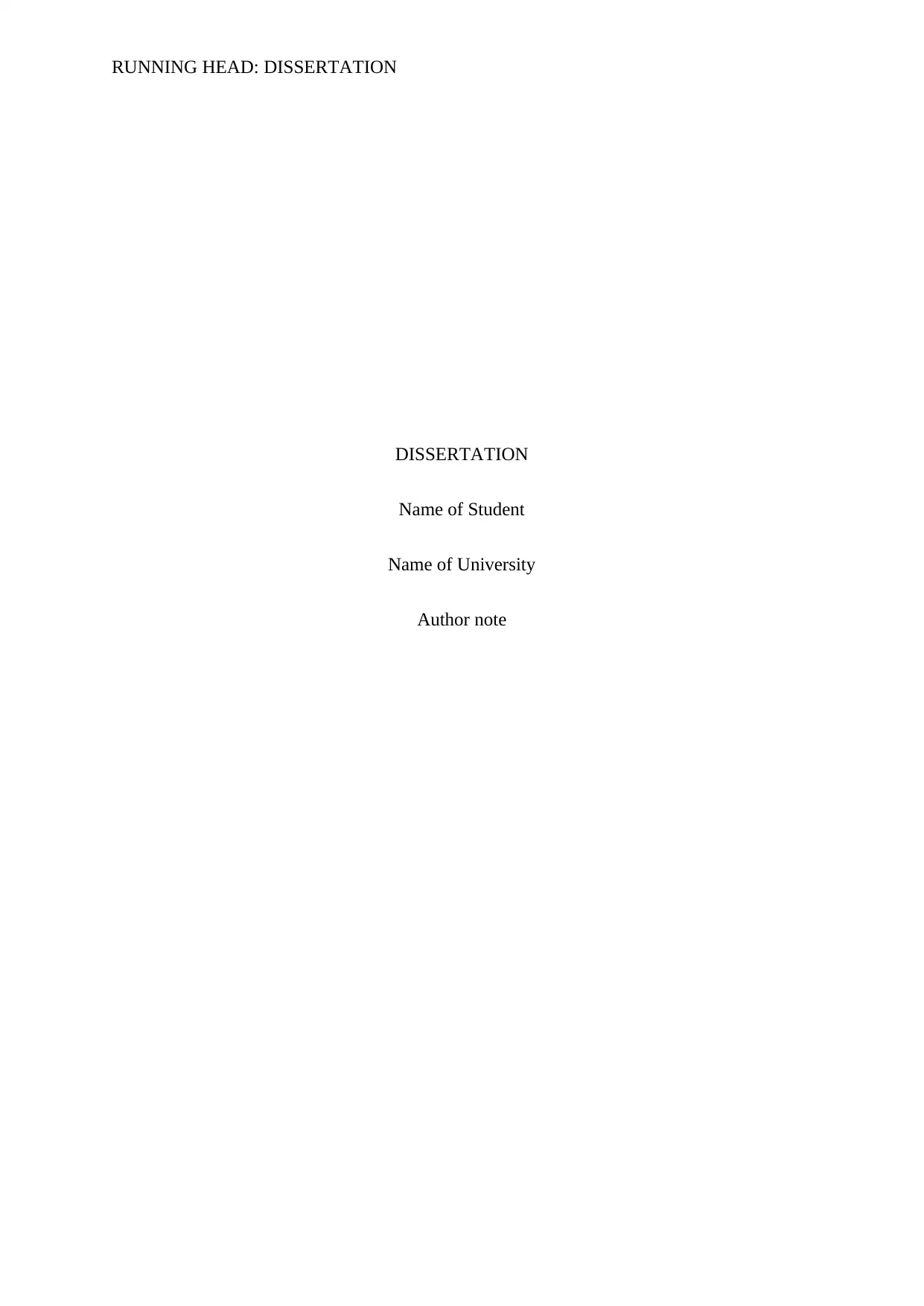
RUNNING HEAD: DISSERTATION
DISSERTATION
Name of Student
Name of University
Author note
DISSERTATION
Name of Student
Name of University
Author note
Paraphrase This Document
Need a fresh take? Get an instant paraphrase of this document with our AI Paraphraser
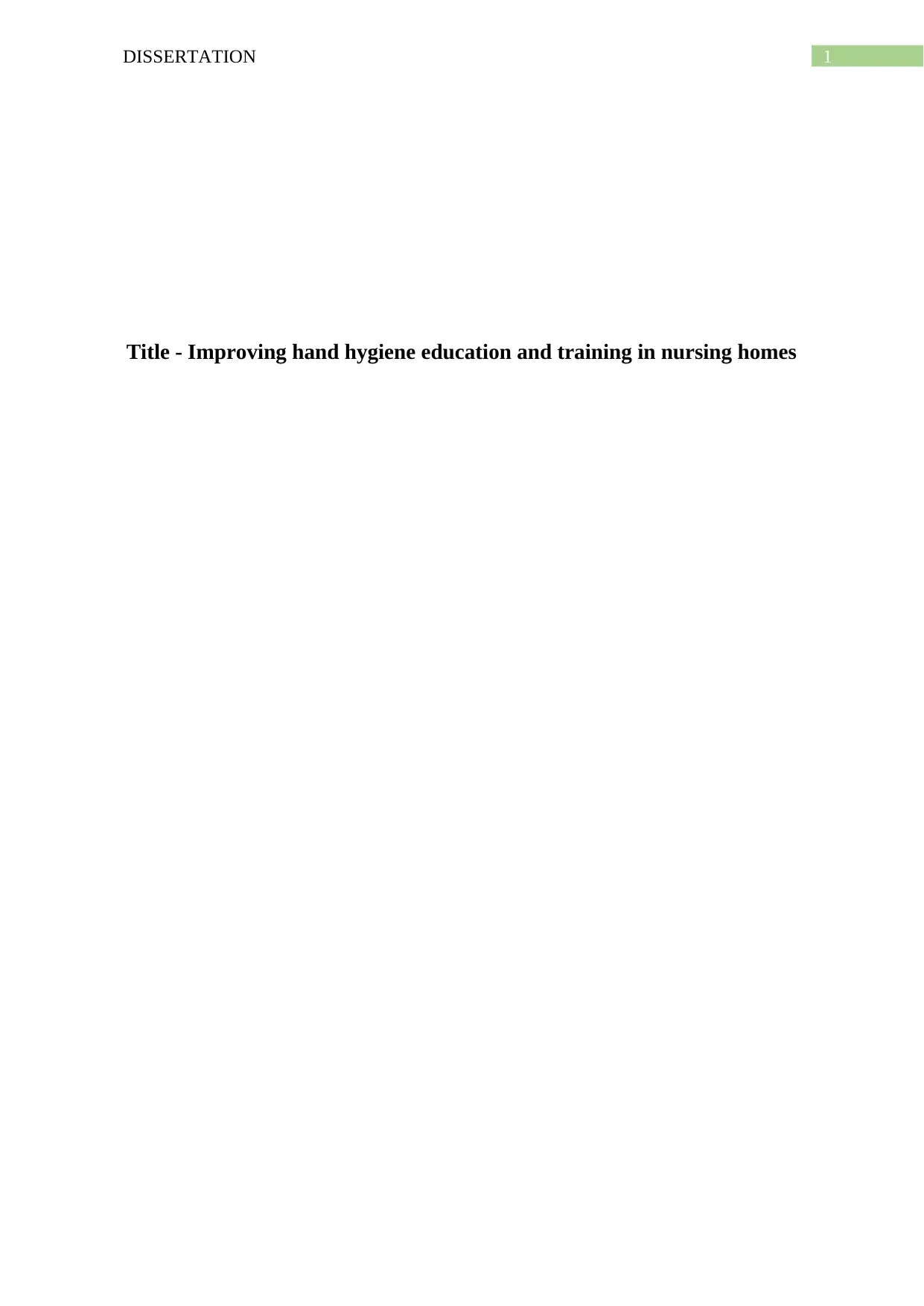
1DISSERTATION
Title - Improving hand hygiene education and training in nursing homes
Title - Improving hand hygiene education and training in nursing homes
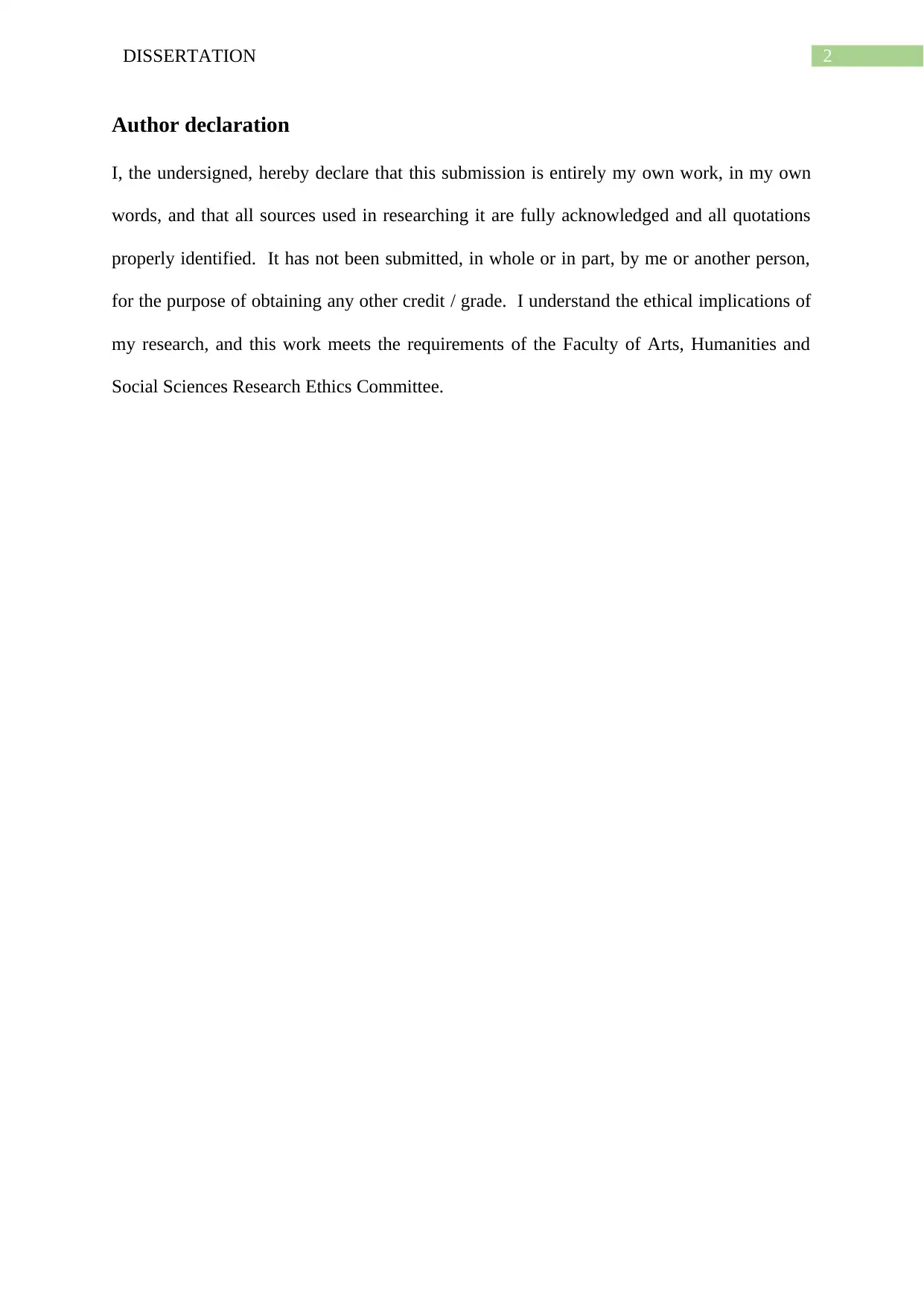
2DISSERTATION
Author declaration
I, the undersigned, hereby declare that this submission is entirely my own work, in my own
words, and that all sources used in researching it are fully acknowledged and all quotations
properly identified. It has not been submitted, in whole or in part, by me or another person,
for the purpose of obtaining any other credit / grade. I understand the ethical implications of
my research, and this work meets the requirements of the Faculty of Arts, Humanities and
Social Sciences Research Ethics Committee.
Author declaration
I, the undersigned, hereby declare that this submission is entirely my own work, in my own
words, and that all sources used in researching it are fully acknowledged and all quotations
properly identified. It has not been submitted, in whole or in part, by me or another person,
for the purpose of obtaining any other credit / grade. I understand the ethical implications of
my research, and this work meets the requirements of the Faculty of Arts, Humanities and
Social Sciences Research Ethics Committee.
⊘ This is a preview!⊘
Do you want full access?
Subscribe today to unlock all pages.

Trusted by 1+ million students worldwide
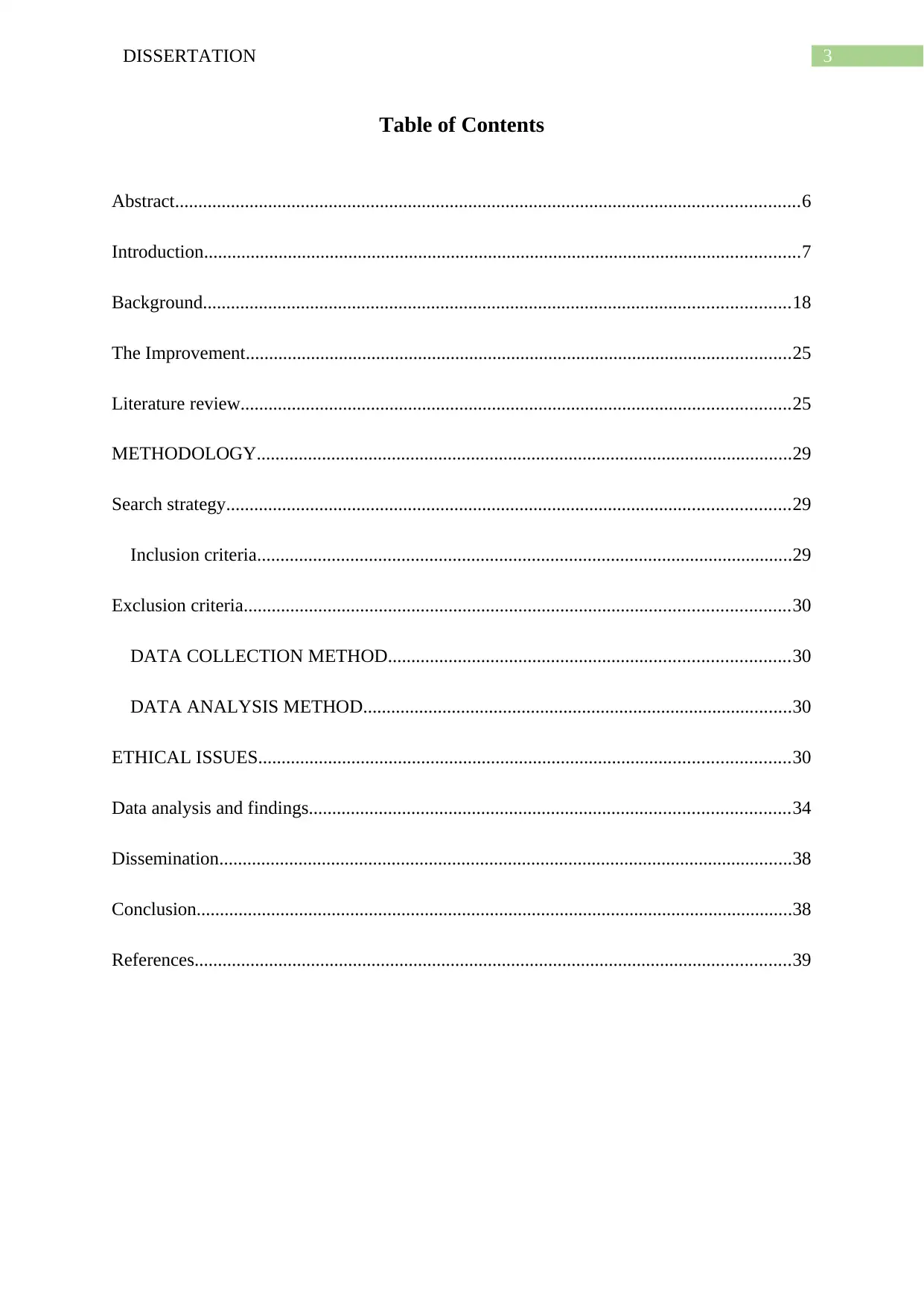
3DISSERTATION
Table of Contents
Abstract......................................................................................................................................6
Introduction................................................................................................................................7
Background..............................................................................................................................18
The Improvement.....................................................................................................................25
Literature review......................................................................................................................25
METHODOLOGY...................................................................................................................29
Search strategy.........................................................................................................................29
Inclusion criteria...................................................................................................................29
Exclusion criteria.....................................................................................................................30
DATA COLLECTION METHOD......................................................................................30
DATA ANALYSIS METHOD............................................................................................30
ETHICAL ISSUES..................................................................................................................30
Data analysis and findings.......................................................................................................34
Dissemination...........................................................................................................................38
Conclusion................................................................................................................................38
References................................................................................................................................39
Table of Contents
Abstract......................................................................................................................................6
Introduction................................................................................................................................7
Background..............................................................................................................................18
The Improvement.....................................................................................................................25
Literature review......................................................................................................................25
METHODOLOGY...................................................................................................................29
Search strategy.........................................................................................................................29
Inclusion criteria...................................................................................................................29
Exclusion criteria.....................................................................................................................30
DATA COLLECTION METHOD......................................................................................30
DATA ANALYSIS METHOD............................................................................................30
ETHICAL ISSUES..................................................................................................................30
Data analysis and findings.......................................................................................................34
Dissemination...........................................................................................................................38
Conclusion................................................................................................................................38
References................................................................................................................................39
Paraphrase This Document
Need a fresh take? Get an instant paraphrase of this document with our AI Paraphraser
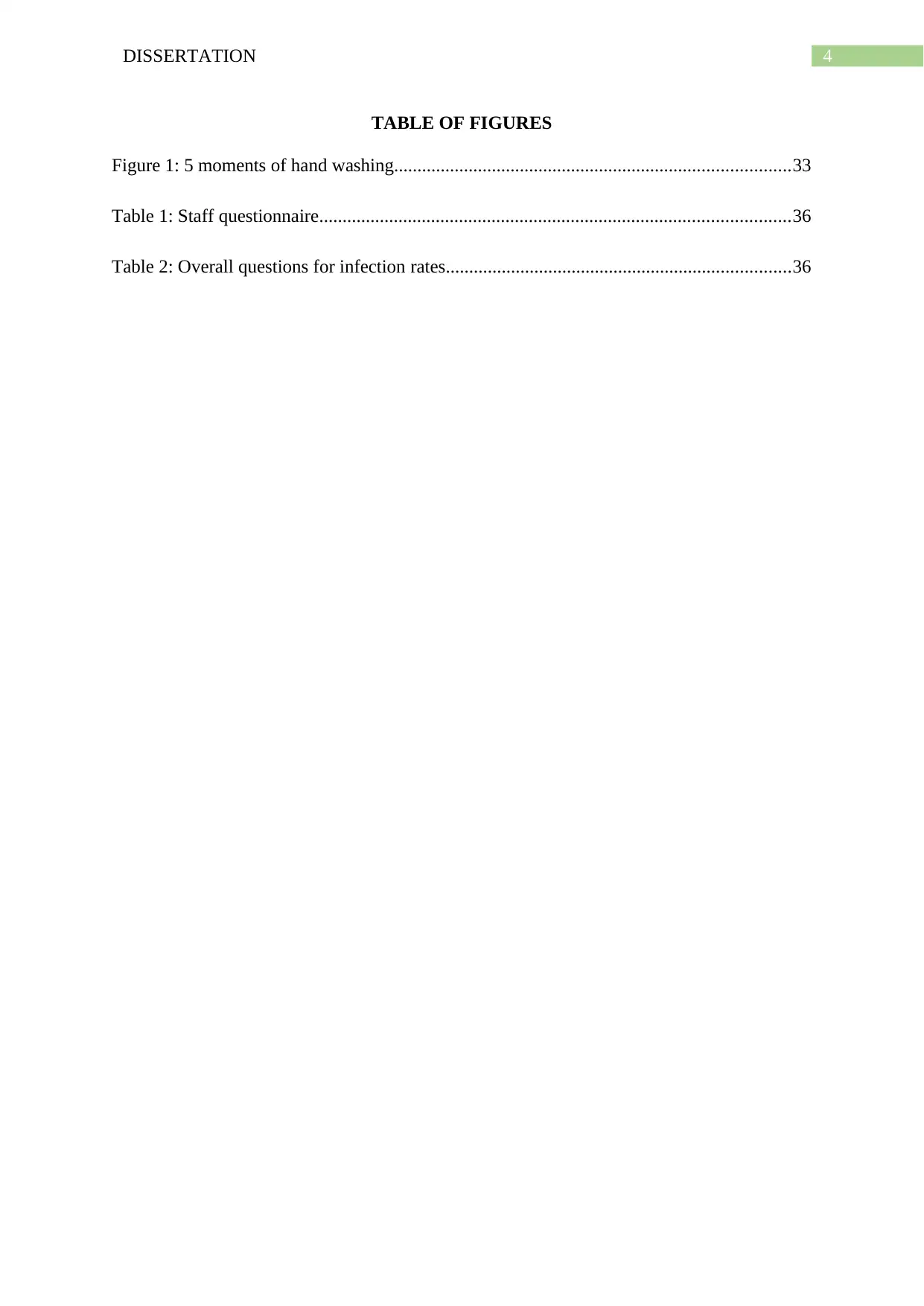
4DISSERTATION
TABLE OF FIGURES
Figure 1: 5 moments of hand washing.....................................................................................33
Table 1: Staff questionnaire.....................................................................................................36
Table 2: Overall questions for infection rates..........................................................................36
TABLE OF FIGURES
Figure 1: 5 moments of hand washing.....................................................................................33
Table 1: Staff questionnaire.....................................................................................................36
Table 2: Overall questions for infection rates..........................................................................36
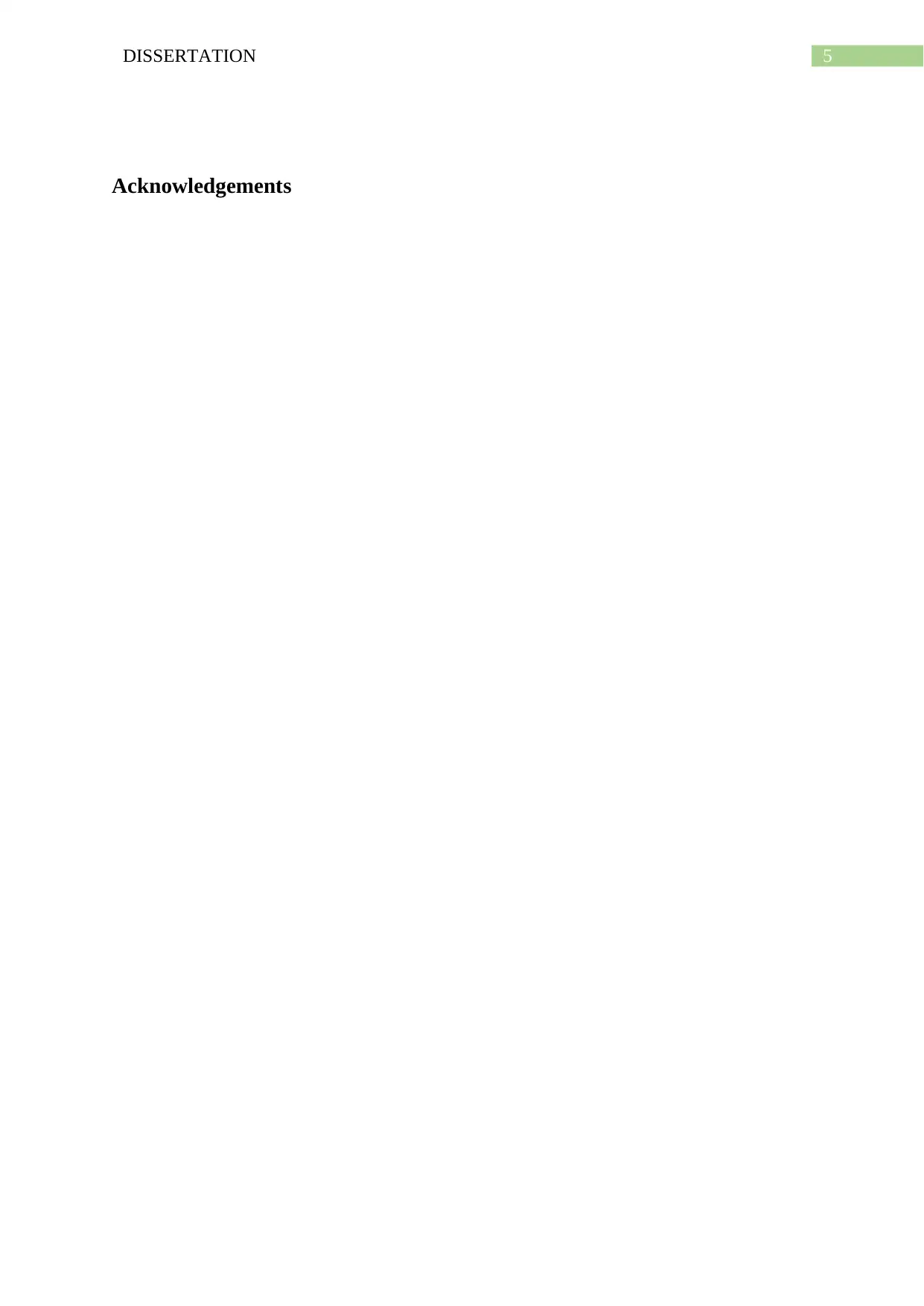
5DISSERTATION
Acknowledgements
Acknowledgements
⊘ This is a preview!⊘
Do you want full access?
Subscribe today to unlock all pages.

Trusted by 1+ million students worldwide
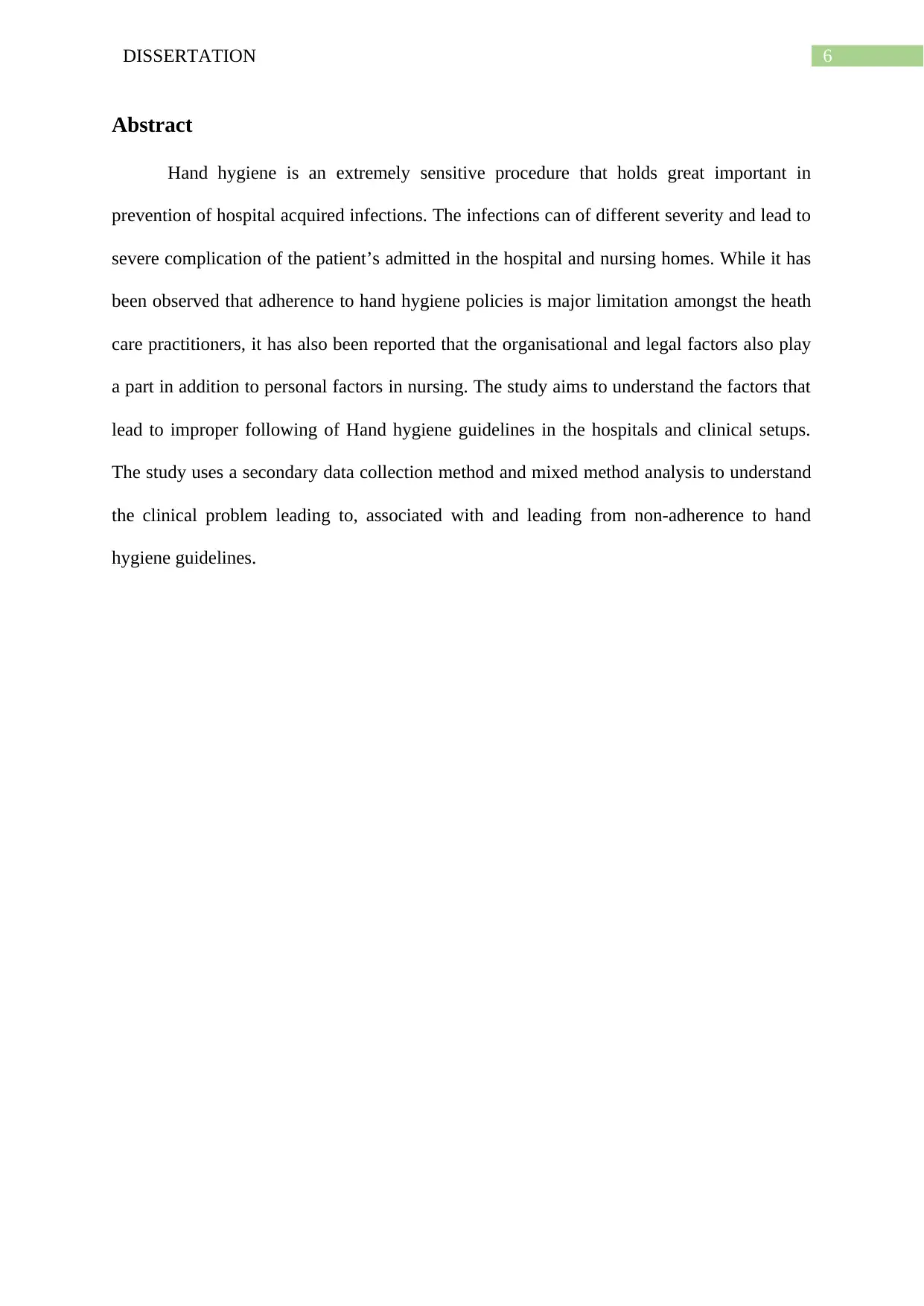
6DISSERTATION
Abstract
Hand hygiene is an extremely sensitive procedure that holds great important in
prevention of hospital acquired infections. The infections can of different severity and lead to
severe complication of the patient’s admitted in the hospital and nursing homes. While it has
been observed that adherence to hand hygiene policies is major limitation amongst the heath
care practitioners, it has also been reported that the organisational and legal factors also play
a part in addition to personal factors in nursing. The study aims to understand the factors that
lead to improper following of Hand hygiene guidelines in the hospitals and clinical setups.
The study uses a secondary data collection method and mixed method analysis to understand
the clinical problem leading to, associated with and leading from non-adherence to hand
hygiene guidelines.
Abstract
Hand hygiene is an extremely sensitive procedure that holds great important in
prevention of hospital acquired infections. The infections can of different severity and lead to
severe complication of the patient’s admitted in the hospital and nursing homes. While it has
been observed that adherence to hand hygiene policies is major limitation amongst the heath
care practitioners, it has also been reported that the organisational and legal factors also play
a part in addition to personal factors in nursing. The study aims to understand the factors that
lead to improper following of Hand hygiene guidelines in the hospitals and clinical setups.
The study uses a secondary data collection method and mixed method analysis to understand
the clinical problem leading to, associated with and leading from non-adherence to hand
hygiene guidelines.
Paraphrase This Document
Need a fresh take? Get an instant paraphrase of this document with our AI Paraphraser
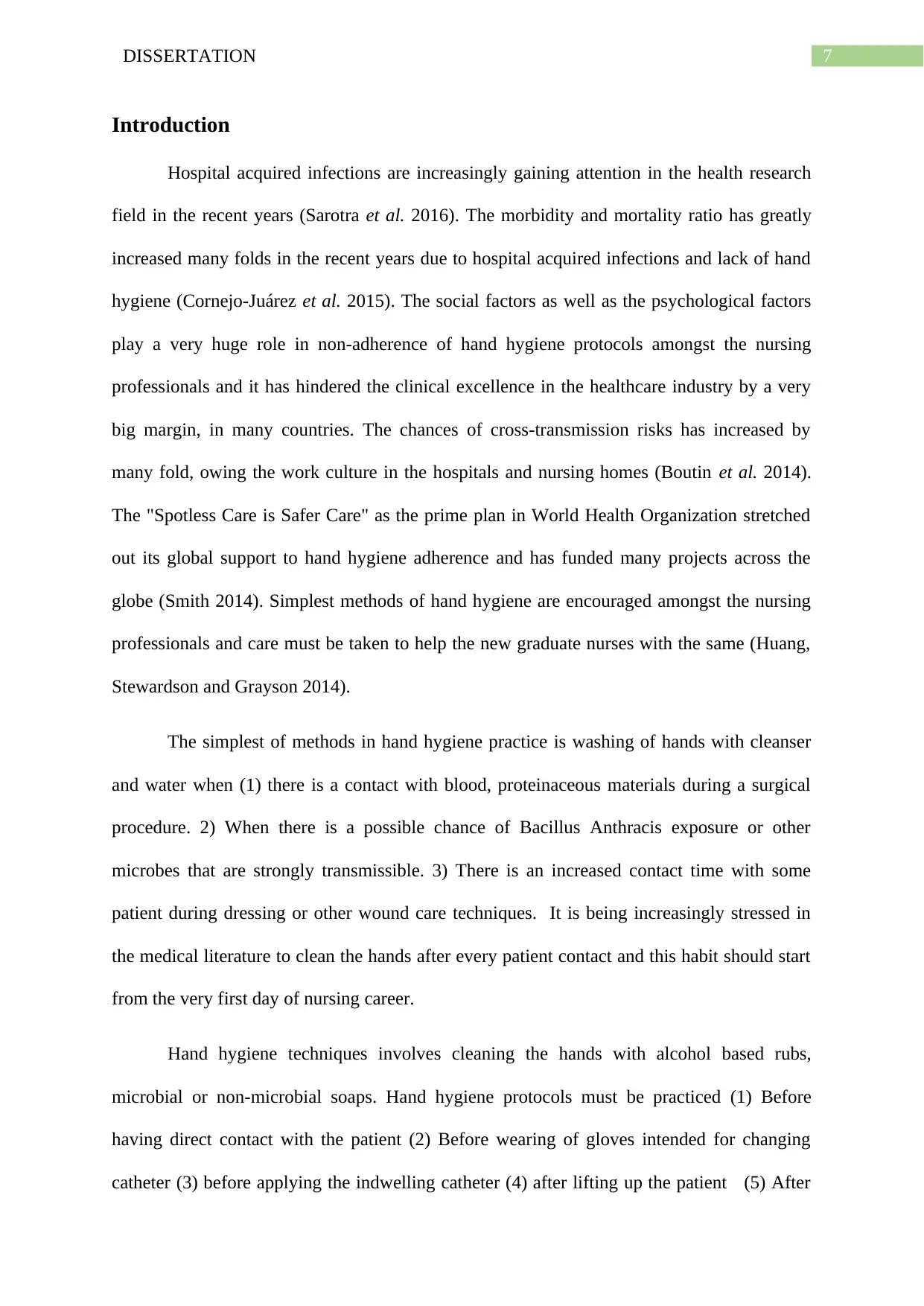
7DISSERTATION
Introduction
Hospital acquired infections are increasingly gaining attention in the health research
field in the recent years (Sarotra et al. 2016). The morbidity and mortality ratio has greatly
increased many folds in the recent years due to hospital acquired infections and lack of hand
hygiene (Cornejo-Juárez et al. 2015). The social factors as well as the psychological factors
play a very huge role in non-adherence of hand hygiene protocols amongst the nursing
professionals and it has hindered the clinical excellence in the healthcare industry by a very
big margin, in many countries. The chances of cross-transmission risks has increased by
many fold, owing the work culture in the hospitals and nursing homes (Boutin et al. 2014).
The "Spotless Care is Safer Care" as the prime plan in World Health Organization stretched
out its global support to hand hygiene adherence and has funded many projects across the
globe (Smith 2014). Simplest methods of hand hygiene are encouraged amongst the nursing
professionals and care must be taken to help the new graduate nurses with the same (Huang,
Stewardson and Grayson 2014).
The simplest of methods in hand hygiene practice is washing of hands with cleanser
and water when (1) there is a contact with blood, proteinaceous materials during a surgical
procedure. 2) When there is a possible chance of Bacillus Anthracis exposure or other
microbes that are strongly transmissible. 3) There is an increased contact time with some
patient during dressing or other wound care techniques. It is being increasingly stressed in
the medical literature to clean the hands after every patient contact and this habit should start
from the very first day of nursing career.
Hand hygiene techniques involves cleaning the hands with alcohol based rubs,
microbial or non-microbial soaps. Hand hygiene protocols must be practiced (1) Before
having direct contact with the patient (2) Before wearing of gloves intended for changing
catheter (3) before applying the indwelling catheter (4) after lifting up the patient (5) After
Introduction
Hospital acquired infections are increasingly gaining attention in the health research
field in the recent years (Sarotra et al. 2016). The morbidity and mortality ratio has greatly
increased many folds in the recent years due to hospital acquired infections and lack of hand
hygiene (Cornejo-Juárez et al. 2015). The social factors as well as the psychological factors
play a very huge role in non-adherence of hand hygiene protocols amongst the nursing
professionals and it has hindered the clinical excellence in the healthcare industry by a very
big margin, in many countries. The chances of cross-transmission risks has increased by
many fold, owing the work culture in the hospitals and nursing homes (Boutin et al. 2014).
The "Spotless Care is Safer Care" as the prime plan in World Health Organization stretched
out its global support to hand hygiene adherence and has funded many projects across the
globe (Smith 2014). Simplest methods of hand hygiene are encouraged amongst the nursing
professionals and care must be taken to help the new graduate nurses with the same (Huang,
Stewardson and Grayson 2014).
The simplest of methods in hand hygiene practice is washing of hands with cleanser
and water when (1) there is a contact with blood, proteinaceous materials during a surgical
procedure. 2) When there is a possible chance of Bacillus Anthracis exposure or other
microbes that are strongly transmissible. 3) There is an increased contact time with some
patient during dressing or other wound care techniques. It is being increasingly stressed in
the medical literature to clean the hands after every patient contact and this habit should start
from the very first day of nursing career.
Hand hygiene techniques involves cleaning the hands with alcohol based rubs,
microbial or non-microbial soaps. Hand hygiene protocols must be practiced (1) Before
having direct contact with the patient (2) Before wearing of gloves intended for changing
catheter (3) before applying the indwelling catheter (4) after lifting up the patient (5) After
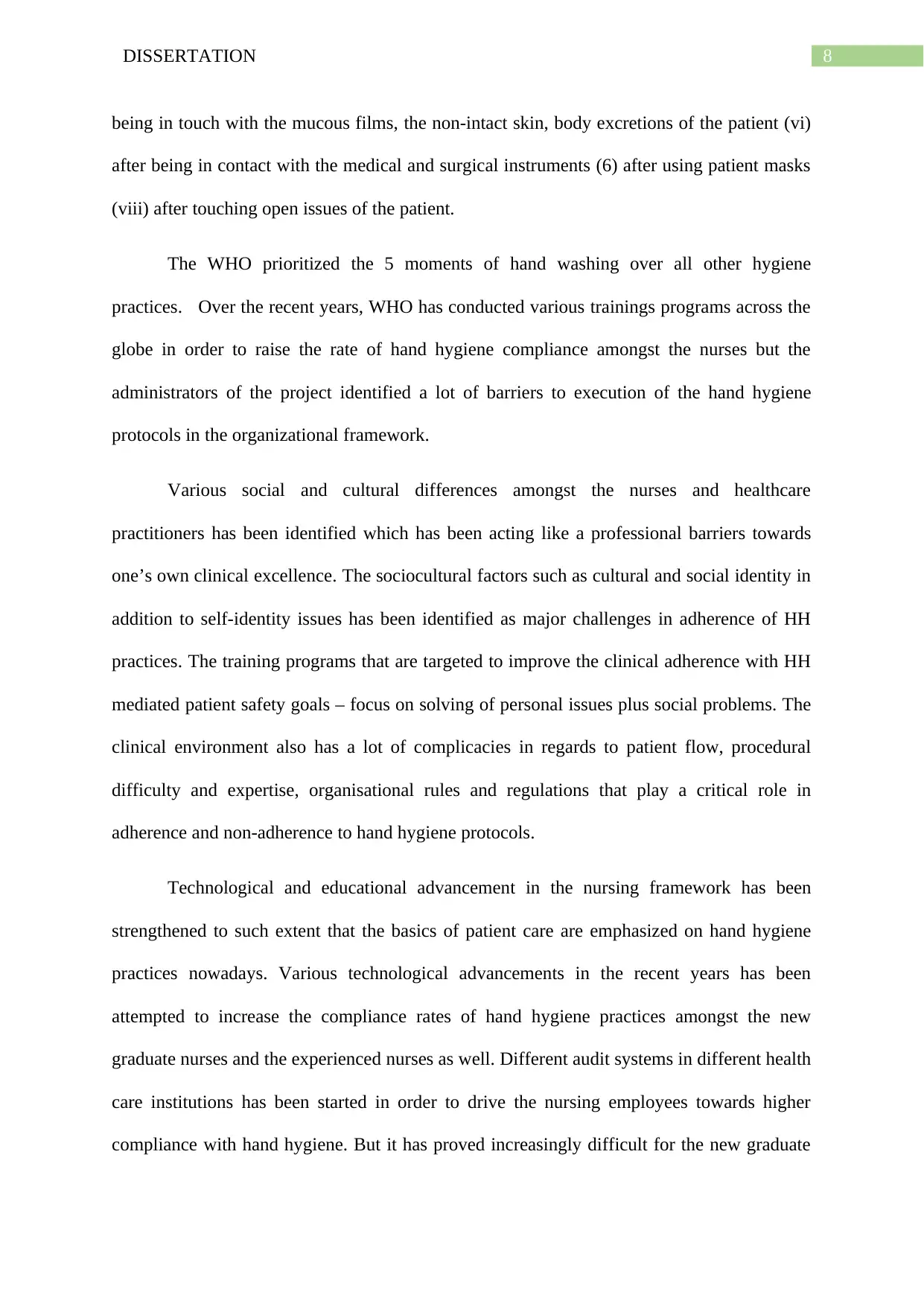
8DISSERTATION
being in touch with the mucous films, the non-intact skin, body excretions of the patient (vi)
after being in contact with the medical and surgical instruments (6) after using patient masks
(viii) after touching open issues of the patient.
The WHO prioritized the 5 moments of hand washing over all other hygiene
practices. Over the recent years, WHO has conducted various trainings programs across the
globe in order to raise the rate of hand hygiene compliance amongst the nurses but the
administrators of the project identified a lot of barriers to execution of the hand hygiene
protocols in the organizational framework.
Various social and cultural differences amongst the nurses and healthcare
practitioners has been identified which has been acting like a professional barriers towards
one’s own clinical excellence. The sociocultural factors such as cultural and social identity in
addition to self-identity issues has been identified as major challenges in adherence of HH
practices. The training programs that are targeted to improve the clinical adherence with HH
mediated patient safety goals – focus on solving of personal issues plus social problems. The
clinical environment also has a lot of complicacies in regards to patient flow, procedural
difficulty and expertise, organisational rules and regulations that play a critical role in
adherence and non-adherence to hand hygiene protocols.
Technological and educational advancement in the nursing framework has been
strengthened to such extent that the basics of patient care are emphasized on hand hygiene
practices nowadays. Various technological advancements in the recent years has been
attempted to increase the compliance rates of hand hygiene practices amongst the new
graduate nurses and the experienced nurses as well. Different audit systems in different health
care institutions has been started in order to drive the nursing employees towards higher
compliance with hand hygiene. But it has proved increasingly difficult for the new graduate
being in touch with the mucous films, the non-intact skin, body excretions of the patient (vi)
after being in contact with the medical and surgical instruments (6) after using patient masks
(viii) after touching open issues of the patient.
The WHO prioritized the 5 moments of hand washing over all other hygiene
practices. Over the recent years, WHO has conducted various trainings programs across the
globe in order to raise the rate of hand hygiene compliance amongst the nurses but the
administrators of the project identified a lot of barriers to execution of the hand hygiene
protocols in the organizational framework.
Various social and cultural differences amongst the nurses and healthcare
practitioners has been identified which has been acting like a professional barriers towards
one’s own clinical excellence. The sociocultural factors such as cultural and social identity in
addition to self-identity issues has been identified as major challenges in adherence of HH
practices. The training programs that are targeted to improve the clinical adherence with HH
mediated patient safety goals – focus on solving of personal issues plus social problems. The
clinical environment also has a lot of complicacies in regards to patient flow, procedural
difficulty and expertise, organisational rules and regulations that play a critical role in
adherence and non-adherence to hand hygiene protocols.
Technological and educational advancement in the nursing framework has been
strengthened to such extent that the basics of patient care are emphasized on hand hygiene
practices nowadays. Various technological advancements in the recent years has been
attempted to increase the compliance rates of hand hygiene practices amongst the new
graduate nurses and the experienced nurses as well. Different audit systems in different health
care institutions has been started in order to drive the nursing employees towards higher
compliance with hand hygiene. But it has proved increasingly difficult for the new graduate
⊘ This is a preview!⊘
Do you want full access?
Subscribe today to unlock all pages.

Trusted by 1+ million students worldwide
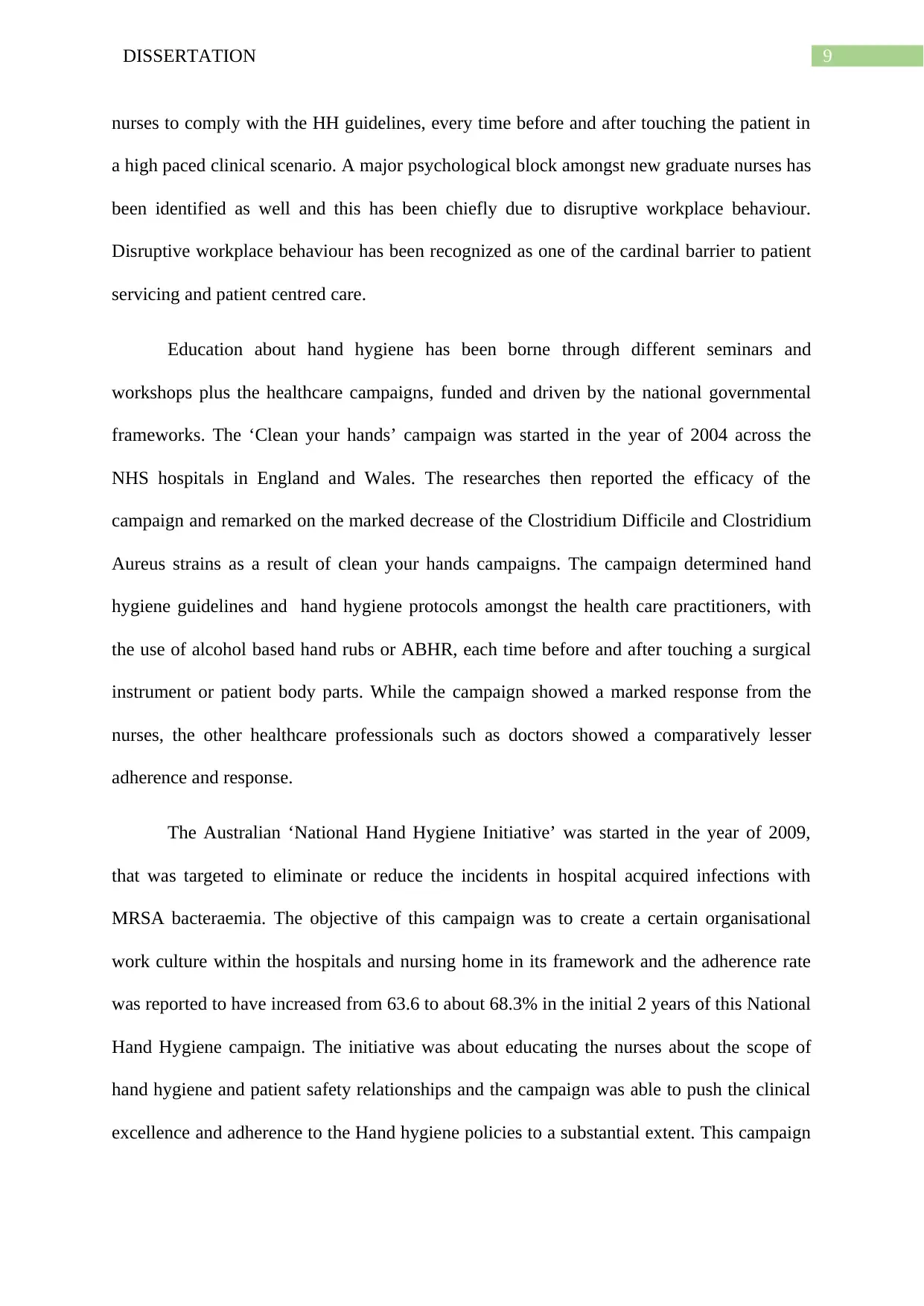
9DISSERTATION
nurses to comply with the HH guidelines, every time before and after touching the patient in
a high paced clinical scenario. A major psychological block amongst new graduate nurses has
been identified as well and this has been chiefly due to disruptive workplace behaviour.
Disruptive workplace behaviour has been recognized as one of the cardinal barrier to patient
servicing and patient centred care.
Education about hand hygiene has been borne through different seminars and
workshops plus the healthcare campaigns, funded and driven by the national governmental
frameworks. The ‘Clean your hands’ campaign was started in the year of 2004 across the
NHS hospitals in England and Wales. The researches then reported the efficacy of the
campaign and remarked on the marked decrease of the Clostridium Difficile and Clostridium
Aureus strains as a result of clean your hands campaigns. The campaign determined hand
hygiene guidelines and hand hygiene protocols amongst the health care practitioners, with
the use of alcohol based hand rubs or ABHR, each time before and after touching a surgical
instrument or patient body parts. While the campaign showed a marked response from the
nurses, the other healthcare professionals such as doctors showed a comparatively lesser
adherence and response.
The Australian ‘National Hand Hygiene Initiative’ was started in the year of 2009,
that was targeted to eliminate or reduce the incidents in hospital acquired infections with
MRSA bacteraemia. The objective of this campaign was to create a certain organisational
work culture within the hospitals and nursing home in its framework and the adherence rate
was reported to have increased from 63.6 to about 68.3% in the initial 2 years of this National
Hand Hygiene campaign. The initiative was about educating the nurses about the scope of
hand hygiene and patient safety relationships and the campaign was able to push the clinical
excellence and adherence to the Hand hygiene policies to a substantial extent. This campaign
nurses to comply with the HH guidelines, every time before and after touching the patient in
a high paced clinical scenario. A major psychological block amongst new graduate nurses has
been identified as well and this has been chiefly due to disruptive workplace behaviour.
Disruptive workplace behaviour has been recognized as one of the cardinal barrier to patient
servicing and patient centred care.
Education about hand hygiene has been borne through different seminars and
workshops plus the healthcare campaigns, funded and driven by the national governmental
frameworks. The ‘Clean your hands’ campaign was started in the year of 2004 across the
NHS hospitals in England and Wales. The researches then reported the efficacy of the
campaign and remarked on the marked decrease of the Clostridium Difficile and Clostridium
Aureus strains as a result of clean your hands campaigns. The campaign determined hand
hygiene guidelines and hand hygiene protocols amongst the health care practitioners, with
the use of alcohol based hand rubs or ABHR, each time before and after touching a surgical
instrument or patient body parts. While the campaign showed a marked response from the
nurses, the other healthcare professionals such as doctors showed a comparatively lesser
adherence and response.
The Australian ‘National Hand Hygiene Initiative’ was started in the year of 2009,
that was targeted to eliminate or reduce the incidents in hospital acquired infections with
MRSA bacteraemia. The objective of this campaign was to create a certain organisational
work culture within the hospitals and nursing home in its framework and the adherence rate
was reported to have increased from 63.6 to about 68.3% in the initial 2 years of this National
Hand Hygiene campaign. The initiative was about educating the nurses about the scope of
hand hygiene and patient safety relationships and the campaign was able to push the clinical
excellence and adherence to the Hand hygiene policies to a substantial extent. This campaign
Paraphrase This Document
Need a fresh take? Get an instant paraphrase of this document with our AI Paraphraser
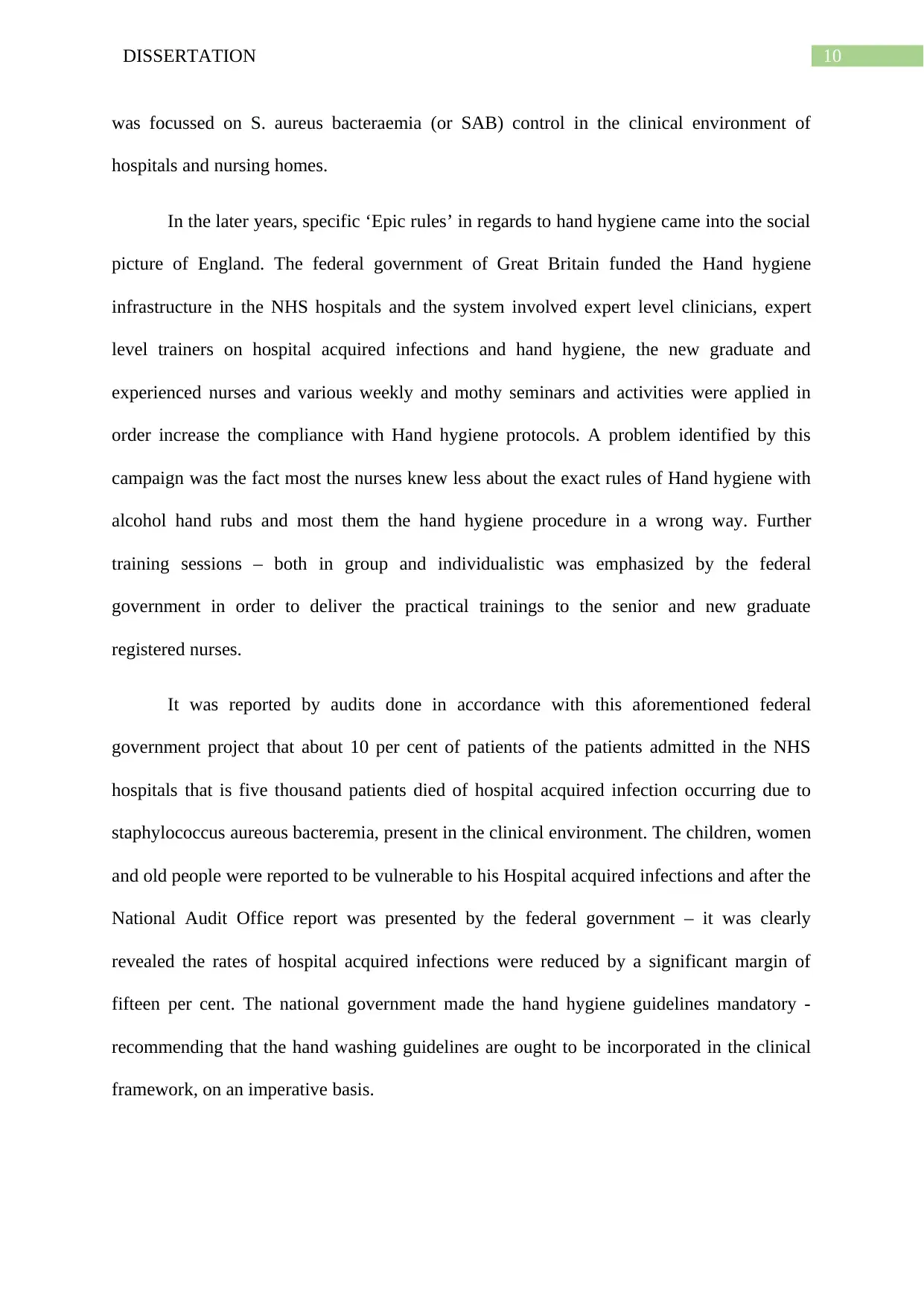
10DISSERTATION
was focussed on S. aureus bacteraemia (or SAB) control in the clinical environment of
hospitals and nursing homes.
In the later years, specific ‘Epic rules’ in regards to hand hygiene came into the social
picture of England. The federal government of Great Britain funded the Hand hygiene
infrastructure in the NHS hospitals and the system involved expert level clinicians, expert
level trainers on hospital acquired infections and hand hygiene, the new graduate and
experienced nurses and various weekly and mothy seminars and activities were applied in
order increase the compliance with Hand hygiene protocols. A problem identified by this
campaign was the fact most the nurses knew less about the exact rules of Hand hygiene with
alcohol hand rubs and most them the hand hygiene procedure in a wrong way. Further
training sessions – both in group and individualistic was emphasized by the federal
government in order to deliver the practical trainings to the senior and new graduate
registered nurses.
It was reported by audits done in accordance with this aforementioned federal
government project that about 10 per cent of patients of the patients admitted in the NHS
hospitals that is five thousand patients died of hospital acquired infection occurring due to
staphylococcus aureous bacteremia, present in the clinical environment. The children, women
and old people were reported to be vulnerable to his Hospital acquired infections and after the
National Audit Office report was presented by the federal government – it was clearly
revealed the rates of hospital acquired infections were reduced by a significant margin of
fifteen per cent. The national government made the hand hygiene guidelines mandatory -
recommending that the hand washing guidelines are ought to be incorporated in the clinical
framework, on an imperative basis.
was focussed on S. aureus bacteraemia (or SAB) control in the clinical environment of
hospitals and nursing homes.
In the later years, specific ‘Epic rules’ in regards to hand hygiene came into the social
picture of England. The federal government of Great Britain funded the Hand hygiene
infrastructure in the NHS hospitals and the system involved expert level clinicians, expert
level trainers on hospital acquired infections and hand hygiene, the new graduate and
experienced nurses and various weekly and mothy seminars and activities were applied in
order increase the compliance with Hand hygiene protocols. A problem identified by this
campaign was the fact most the nurses knew less about the exact rules of Hand hygiene with
alcohol hand rubs and most them the hand hygiene procedure in a wrong way. Further
training sessions – both in group and individualistic was emphasized by the federal
government in order to deliver the practical trainings to the senior and new graduate
registered nurses.
It was reported by audits done in accordance with this aforementioned federal
government project that about 10 per cent of patients of the patients admitted in the NHS
hospitals that is five thousand patients died of hospital acquired infection occurring due to
staphylococcus aureous bacteremia, present in the clinical environment. The children, women
and old people were reported to be vulnerable to his Hospital acquired infections and after the
National Audit Office report was presented by the federal government – it was clearly
revealed the rates of hospital acquired infections were reduced by a significant margin of
fifteen per cent. The national government made the hand hygiene guidelines mandatory -
recommending that the hand washing guidelines are ought to be incorporated in the clinical
framework, on an imperative basis.
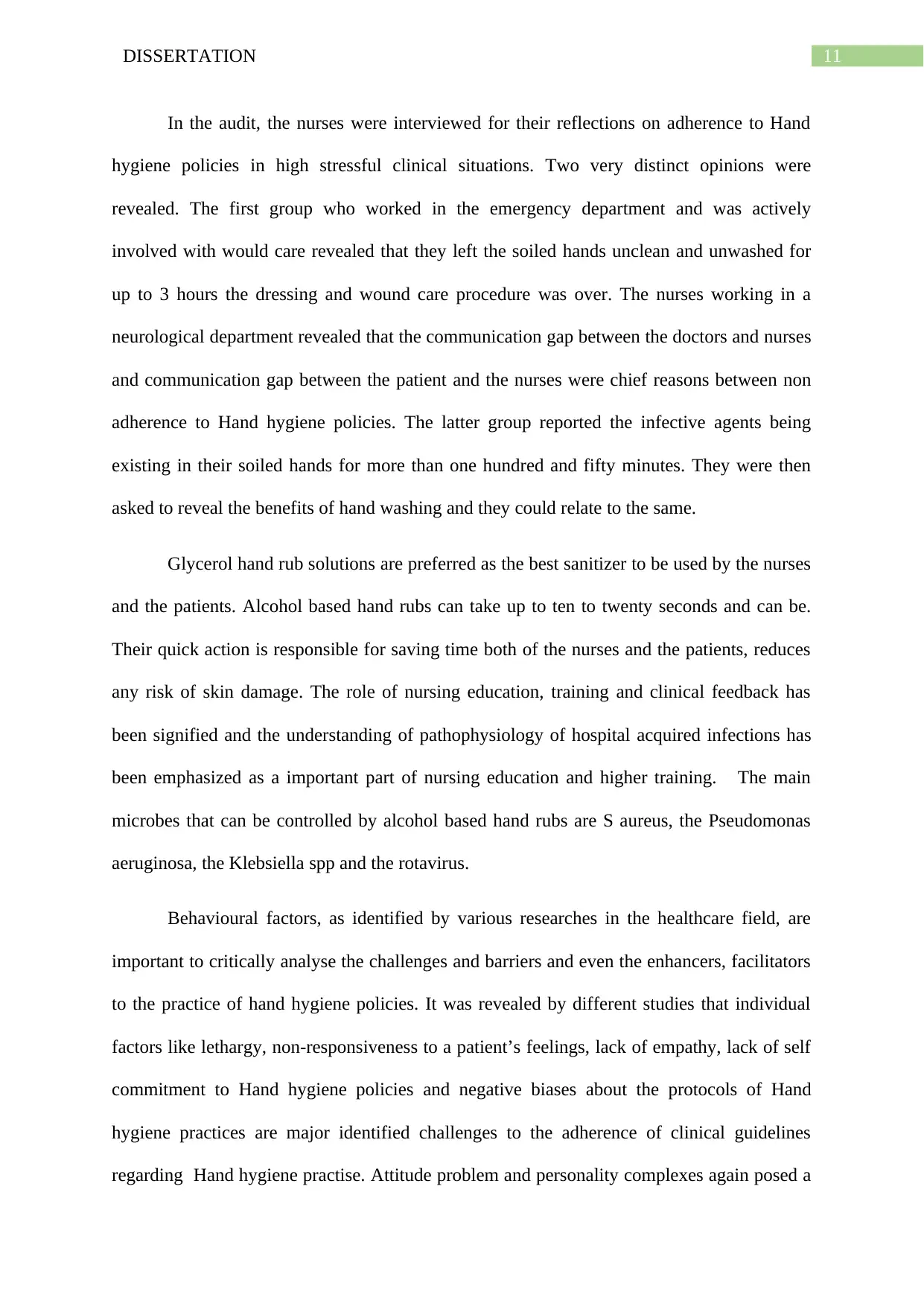
11DISSERTATION
In the audit, the nurses were interviewed for their reflections on adherence to Hand
hygiene policies in high stressful clinical situations. Two very distinct opinions were
revealed. The first group who worked in the emergency department and was actively
involved with would care revealed that they left the soiled hands unclean and unwashed for
up to 3 hours the dressing and wound care procedure was over. The nurses working in a
neurological department revealed that the communication gap between the doctors and nurses
and communication gap between the patient and the nurses were chief reasons between non
adherence to Hand hygiene policies. The latter group reported the infective agents being
existing in their soiled hands for more than one hundred and fifty minutes. They were then
asked to reveal the benefits of hand washing and they could relate to the same.
Glycerol hand rub solutions are preferred as the best sanitizer to be used by the nurses
and the patients. Alcohol based hand rubs can take up to ten to twenty seconds and can be.
Their quick action is responsible for saving time both of the nurses and the patients, reduces
any risk of skin damage. The role of nursing education, training and clinical feedback has
been signified and the understanding of pathophysiology of hospital acquired infections has
been emphasized as a important part of nursing education and higher training. The main
microbes that can be controlled by alcohol based hand rubs are S aureus, the Pseudomonas
aeruginosa, the Klebsiella spp and the rotavirus.
Behavioural factors, as identified by various researches in the healthcare field, are
important to critically analyse the challenges and barriers and even the enhancers, facilitators
to the practice of hand hygiene policies. It was revealed by different studies that individual
factors like lethargy, non-responsiveness to a patient’s feelings, lack of empathy, lack of self
commitment to Hand hygiene policies and negative biases about the protocols of Hand
hygiene practices are major identified challenges to the adherence of clinical guidelines
regarding Hand hygiene practise. Attitude problem and personality complexes again posed a
In the audit, the nurses were interviewed for their reflections on adherence to Hand
hygiene policies in high stressful clinical situations. Two very distinct opinions were
revealed. The first group who worked in the emergency department and was actively
involved with would care revealed that they left the soiled hands unclean and unwashed for
up to 3 hours the dressing and wound care procedure was over. The nurses working in a
neurological department revealed that the communication gap between the doctors and nurses
and communication gap between the patient and the nurses were chief reasons between non
adherence to Hand hygiene policies. The latter group reported the infective agents being
existing in their soiled hands for more than one hundred and fifty minutes. They were then
asked to reveal the benefits of hand washing and they could relate to the same.
Glycerol hand rub solutions are preferred as the best sanitizer to be used by the nurses
and the patients. Alcohol based hand rubs can take up to ten to twenty seconds and can be.
Their quick action is responsible for saving time both of the nurses and the patients, reduces
any risk of skin damage. The role of nursing education, training and clinical feedback has
been signified and the understanding of pathophysiology of hospital acquired infections has
been emphasized as a important part of nursing education and higher training. The main
microbes that can be controlled by alcohol based hand rubs are S aureus, the Pseudomonas
aeruginosa, the Klebsiella spp and the rotavirus.
Behavioural factors, as identified by various researches in the healthcare field, are
important to critically analyse the challenges and barriers and even the enhancers, facilitators
to the practice of hand hygiene policies. It was revealed by different studies that individual
factors like lethargy, non-responsiveness to a patient’s feelings, lack of empathy, lack of self
commitment to Hand hygiene policies and negative biases about the protocols of Hand
hygiene practices are major identified challenges to the adherence of clinical guidelines
regarding Hand hygiene practise. Attitude problem and personality complexes again posed a
⊘ This is a preview!⊘
Do you want full access?
Subscribe today to unlock all pages.

Trusted by 1+ million students worldwide
1 out of 48
Your All-in-One AI-Powered Toolkit for Academic Success.
+13062052269
info@desklib.com
Available 24*7 on WhatsApp / Email
![[object Object]](/_next/static/media/star-bottom.7253800d.svg)
Unlock your academic potential
Copyright © 2020–2025 A2Z Services. All Rights Reserved. Developed and managed by ZUCOL.


